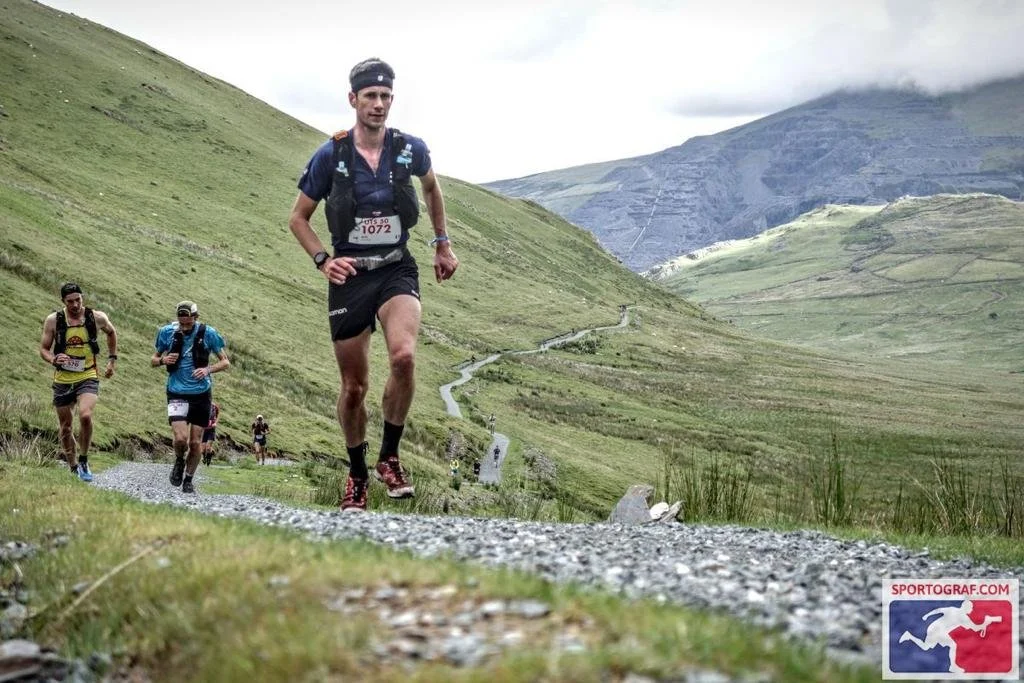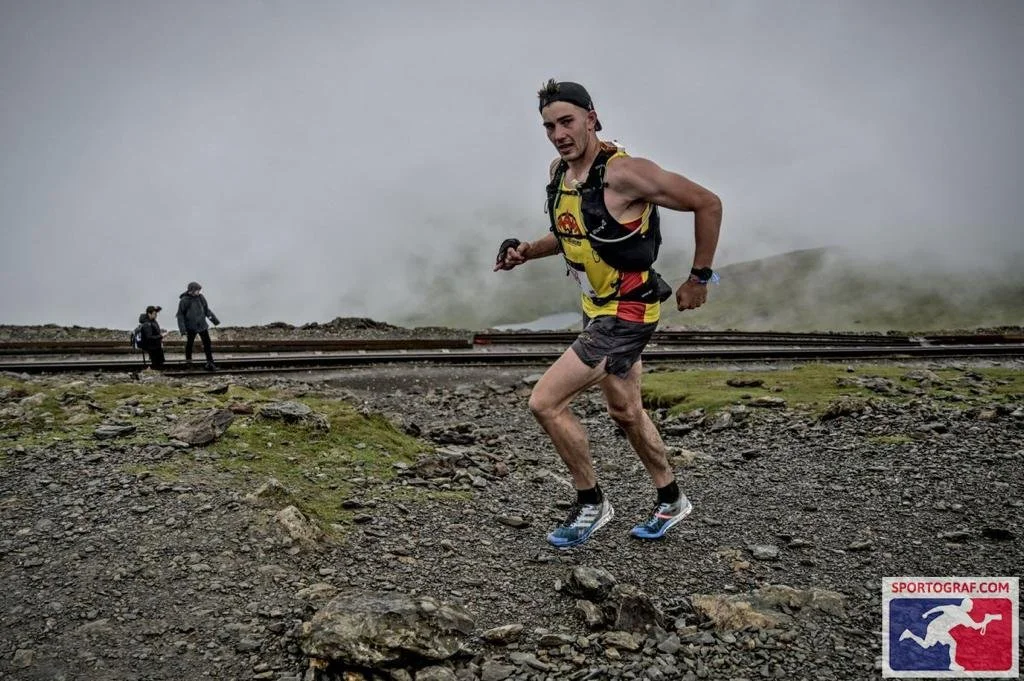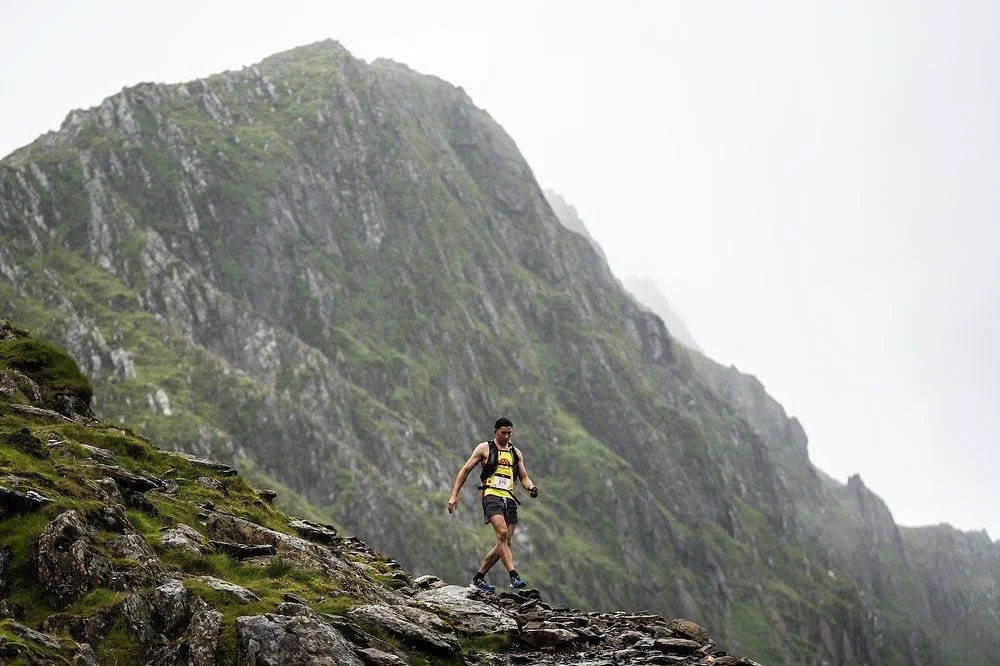Racing UTS50 by UTMB
by George Blackwell
They say UTS (Ultra-Trail Snowdonia by UTMB) is “Beautiful beyond belief, savage beyond reason.” I would agree!
The main event packs in a whopping 3,300m of ascent over 55 km (just like all trail running races, the distance in the name doesn’t exactly correlate with the miles on the ground!). But it’s also extremely technical, with amazing vertigo-inducing ridge running, steep descents and a lot of fantastic scenery (on a good day!). I raced it in 2022 and learnt a lot about Welsh mountain running in the process!
Training Approach
There’s actually very little to explain with regards to my own preparation for this race, as there was almost no specific training! I’d spent most of January-April 2022 preparing for Ironman Bolton, but as the event loomed closer, I couldn’t get myself excited at the prospect of cycling and running loops of Bolton Town Centre (weirdly). Ironman Bolton has amazing support on course and is a very well organised race, but to get the best out of yourself in any ultra-distance race, you need a clear reason ‘why’ to fall back on as the suffering develops in the latter stages. For me, this why was nowhere near clear enough, so I made a last-minute call to enter UTS 50km instead. I made this decision in late May / early June, having been inspired by pictures and videos from the TMR Coaching training camp in Llanberis. This gave me 4 weeks to get myself physically and mentally in the best possible position to be compete.
As I’d been preparing for an Ironman, from an aerobic standpoint I knew I was in a good position. The main concern was to condition my legs for long, technical descents I had little experience of. I’ve raced over 30-50km in mountainous races multiple times before, but the nature of these were short sharp inclines, rather than longer more technical trails that I’d be required to manage at UTS. Within the 4 week time frame, I managed to squeeze in a 7 day training camp in the Isle of Man (home for me), where I deliberately found the longest and most technical descent I could (roughly 2.4km, 500m vertical top to bottom) and over 2 key sessions did 90 mins and 120 mins of hill reps where the emphasis was on running down fast but smooth with short steps, staying as light on my feet as possible to preserve my legs. Although the physiological adaptions you can make from a couple of sessions is very limited, this certainly prepared me psychologically for the type of fatigue I was likely to experience if I didn’t pace myself right or ran the early descents too hard. Additionally, research has shown that the repeated bout effect in relation to downhill running does not take too many sessions to see adaptations, so it was a worthwhile training block.
The rest of the preparation looked like maintaining consistent aerobic volume from both running and cycling, keeping up with my S+C, sleeping as much as possible, and trying to orientate myself as best as possible with the route maps.
Are you racing UTS50?
Get 15% off a TMR training plan with the code GEORGE 👇🏻
The Race
The first half of a race is a bit of a blur. I deliberately went out with the front bunch out of Llanberis as there were a couple of stiles and gates early on the course where there would be a lot of congestion with the 700+ starters. Like other efforts I’ve done over 50km, the first hour feels very comfortable but it’s so hard to know how comfortable is really comfy enough. I rolled around to the first aid station at 16km in a strong but controlled effort and executed my nutrition top up as planned as well as taking the opportunity to get some extra fluid in and nabbing an extra banana.
By the 25km aid station I’d made up several places. I knew I was in the top 15 ish going through the first aid station, but as we hit the first steep climb of the day up to the summit of Myndd Mawr, I began working my way through the field, with many people flagging having gone out too hard. I had a few issues with my shoe choice on the descent to the ‘Snowdon Base Camp’ Aid station, with my Terrex Ultras not having big enough lugs to keep me upright the entire time on the way down. The terrain over this route was so varied there was no perfect shoe choice, but something more soft ground suited would have made a substantial difference here. When I arrived at the aid station, the volunteers confirmed I was in 3rd/4th place with the runner I was with, which was very promising and not a position I anticipated being in prior to the race.
Spirits were high as I started the long ascent of Snowdon, but the fog and rain en route to the summit soon put an end to that. I was now firmly in 4th place with TMR Athlete George Fisher (who eventually finished 2nd place) getting away from me up the climb. This was the section where a recce would have made an exponential amount of difference – thus far the technicality of the course wasn’t as serious as I anticipated but I was brought down to earth by the section from the summit of Snowdon to Y’Lliwedd which was more of a scramble than a trail. There were several points I had to stop to try to reorientate myself in the fog with the flags being difficult to spot in the conditions, but thankfully I managed to stay on route. Unfortunately, I rolled my left ankle getting over the summit of Y’Lliwedd which was a psychological challenge I’d not had to navigate before. The ankle made a loud ‘clunk’ and initially left me scared to weight bare under the possibility it was dislocated or broken. Thankfully after a few ginger steps, it appeared it would take some weight but was far from comfortable. Had I been at a different point in the race, this might have been the end of the day for me, but the position I was in meant I had little choice but to attempt to ‘walk it off’ as logistically and morally I knew it wasn’t warranted to get rescued off the mountain (let alone the hit my ego would take), so was forced to do my best to keep moving slowly over the technical terrain. This section has been removed from the course for 2023, which is both relieving and disappointing at the same time. It was a unique type of challenging that I enjoyed racing but can understand it being a too much for those less comfortable with risk.
Interestingly, my slump in pace to manage my ankle didn’t affect places too much due to the nature of the terrain, it was mostly scrambling down technical descents until a short and runnable section to the final Aid Station at the bottom of the Pyg Track. Despite continuous negotiation with myself over this 90-minute period, when I arrived at the last checkpoint in 5th place with 12km to go, I knew there was no chance I was going to let myself DNF. At this point I was still 1st U25 and significantly closer to the podium than I’d expected at the start of the day, so even if I had to walk my way back that would be a result. I managed to get up the final climb of Snowdon in reasonable time, but over the final descent lost two places where it was much more runnable. It was frustrating to slip out of the top 5, but I was proud of my effort and pleased with the way I’d dealt with a mid-race injury / wobble.
Training Points and Lessons Learnt
Expect to be challenged. The psychological prep for an event like this shouldn’t be under-valued. It is highly likely you’ll encounter problems you didn’t anticipate. For me it was an issue with my ankle, but for others it could be going off course, nutrition, or kit malfunctions. You can’t plan for every eventuality, so an element of problem solving is going to be necessary. Prepare well and have strategies in place to help you move through it, whatever the challenge might be.
If you want to race well on technical trails, you need to spend time on technical trails. Sounds obvious, but the trip you’re putting off to the mountains instead of another local long run from home could make the difference when wanting to hit your goals on race day!
Train to the profile of the route. Try to work out how many metres of ascent / descent you’ll do per mile / km in the race, and replicate this where you can in key sessions. The closer you get to the event, the more specific you want to be.
If possible, recce the course. Watching TMR athlete George Fisher disappear up Snowdon was a shame, one to lose so much time, but also to miss seeing him fly down the technical descents, showing the benefit of spending time on the course in advance.
Don’t neglect mental training. There’s a lot to be gained from mental training and visualisation in these types of gruelling events, especially in case something goes wrong. Check out this article on how Doug dealt with a serious mishap during his first UTMB to see what I mean and get some tips.
Are you racing uts50 or have any questions?
Check out this 14-week training plan for UTS on TrainingPeaks and use code GEORGE to get 15% off:
Want to be coached for UTS50, any Ultra-Trail Snowdonia by UTMB race or similar events? Contact me:



